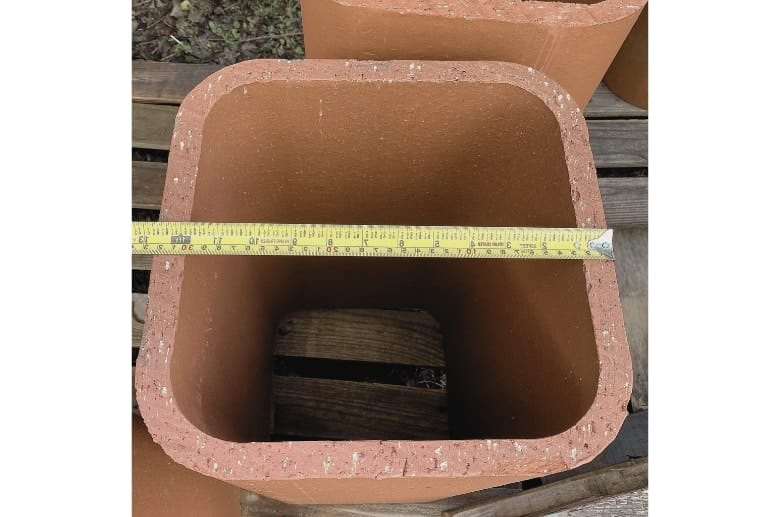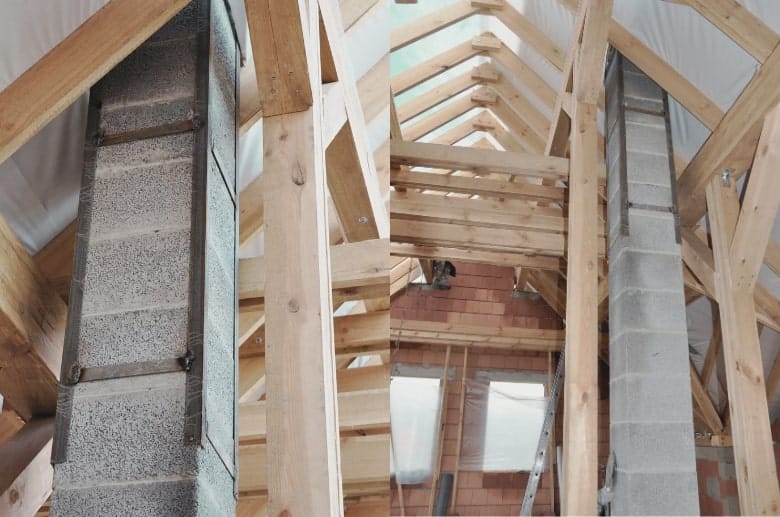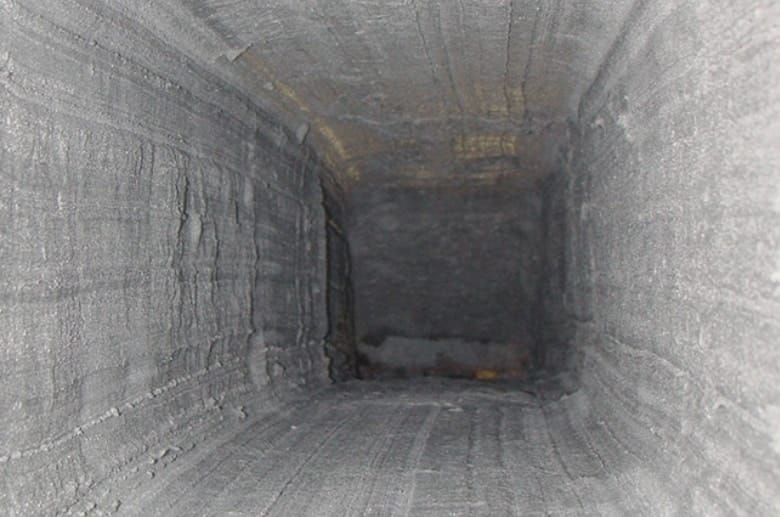Research from the National Fire Protection Association indicates that a fireplace or a chimney was responsible for 7% of fires and about 22% of direct property damage between 2016 and 2020. This gives homeowners more reasons to think about the chimney and its components.
The chimney liner needs particular attention. While it may not be the most glamorous part of your fireplace, a chimney liner is crucial in keeping your home safe and sound.
So, what exactly is a chimney liner? Simply put, it’s a protective barrier installed inside the chimney to safely contain and guide the byproducts of combustion out of your house.
Two popular options stand out when choosing the right type of liner: heat shield vs stainless steel chimney liner. While both provide excellent protection, there are some key differences to consider when making your decision. This guide will compare the two liners and discuss their pros and cons.
Understanding Chimney Liners
Your chimney is more than just a single component, each playing a specific role. One of the most crucial components is the chimney liner.
Your chimney liner has two primary functions: to protect your home from heat and provide a conduit for smoke and gases from burning wood to escape.
Role of the Chimney Liner
One of the key benefits of chimney liners is their ability to reduce creosote buildup. Research shows that the main cause of home heating fires (30%) is a dirty chimney, typically from creosote buildup.
In addition, a properly installed chimney liner acts as a barrier, preventing direct contact between the chimney’s hot surfaces and the surrounding building materials. Chimney liners contribute to the improvement of chimney efficiency. When a chimney is unlined or has a damaged liner, it can hinder proper draft and airflow.
Chimney liners also play a crucial role in venting exhaust gases safely to the outside. They facilitate the efficient expulsion of harmful gases like carbon monoxide.
Types of Chimney Liners
Three types of chimney liners are available on the market: stainless steel, clay flue, and cast-in-place liners. Let’s see how they compare.
1. Stainless Steel Liners

Stainless steel chimney liners are made from a corrosion-resistant alloy, typically 316L or 304 stainless steel, that can withstand high temperatures and resist the corrosive byproducts of combustion.
The benefits of stainless steel liners include the following:
- Long lifespan
- Ease of installation
- Compatibility with different fuel types
They also provide a smooth, airtight passage for the flue gases, improving draft and reducing creosote buildup.
2. Clay Flue Liners

Clay flue liners have been used for centuries and are a traditional choice for masonry chimneys. These liners are made from clay or ceramic material and are shaped like hollow tubes that fit inside the chimney. They offer good resistance to heat and are relatively inexpensive compared to other options.
3. Cast-in-place Liners

Cast-in-place liners are a versatile option that involves creating a new liner within the existing chimney structure. This method typically involves applying a special cement-like material to the interior walls of the chimney, forming a smooth and durable liner.
Cast-in-place liners offer excellent insulation properties and can improve the overall structural integrity of the chimney.
What is a Heat Shield Liner?

A heat shield liner is a technology designed to protect chimneys and flue systems from the intense heat generated by fires. Unlike non-heat-shielded chimneys, this liner acts as a barrier, preventing direct contact between the hot chimney surfaces and surrounding building materials. Doing so reduces the risk of ignition and improves chimney efficiency by maintaining proper draft and airflow.
Heatshield liners are typically made of either carbon or aluminium materials that can withstand high temperatures and offer excellent insulation properties.
Some manufacturers may also use other advanced materials that provide similar heat protection and insulation benefits. Speaking of manufacturers, several reputable companies produce heat shield liners, including JBC, Technologies, Inc, Firwin Corp, and Valmet Inc, among others.
It’s important to choose a trusted and experienced manufacturer to ensure the quality and reliability of the product. Conducting research and seeking recommendations from professionals in the field can help you find a reliable heat shield liner manufacturer.
Advantages of Heat Shield Liners
There are several advantages associated with heat shield liners. These include:
- Increased heat efficiency: Heat shield liners help to extract more heat from the combustion gases, maximizing the heat transfer to the living space. Studies have shown that heat shield liners can increase heat efficiency by up to 26%.
- Longer lifespan than other liners: Unlike traditional flue tiles or mortar joints that may deteriorate over time, heat shield liners can withstand high temperatures and harsh conditions without showing signs of wear. This extended lifespan reduces the need for frequent repairs or replacements, saving time and money in the long run.
- Ability to repair damaged or deteriorated mortar joints and flue tiles: Rather than undergoing a complete replacement, which can be costly and time-consuming, heat shield liners can be installed to cover the damaged areas, providing an effective solution and restoring the chimney’s functionality.
- Prevents chimney fires and carbon monoxide poisoning: The added insulation and protection these liners provide create a barrier that minimizes the chance of heat transfer to combustible materials. This prevents dangerous situations, keeps the chimney in better condition, and promotes safe chimney operation.
Disadvantages of Heat Shield Liners
Where there are advantages, there are also some disadvantages, and here are a few for heat shield liners:
- Application limitations and constraints: While heat shield liners offer numerous benefits, they may have certain limitations and constraints. Factors such as the size and configuration of the chimney and local building codes can affect the suitability and feasibility of installing a heat shield liner.
- Possible issues and defects: Choose a reputable manufacturer and ensure proper installation by qualified professionals. Regular inspections and maintenance can also help identify and address potential issues before they become significant.
What is a Stainless Steel Chimney Liner?

Stainless steel chimney liners are the most popular for venting wood-burning fireplaces and stoves. These liners are typically made from stainless steel alloys, such as 304 or 316-grade stainless steel.
Grade 304 stainless steel is a general-purpose stainless steel that provides good corrosion resistance and is suitable for most residential applications. Grade 316 stainless steel, on the other hand, offers enhanced corrosion resistance, making it a better choice for areas with higher acidity levels, such as those near coastal regions.
Moreover, stainless steel liner technology utilizes durable stainless steel materials to withstand the harsh conditions and high temperatures of chimney operation.
Advantages of Stainless Steel Chimney Liners
The advantages of stainless steel chimney liners include the following:
- Durability and strength: Stainless steel chimney liners are designed to resist cracking, warping, and deterioration over time, ensuring long-lasting performance.
- Resistance to creosote buildup and corrosion: Stainless steel liners have a smooth surface, which means that they do not allow creosote to build up easily and therefore reduce the risk of chimney fires. Additionally, stainless steel is highly resistant to corrosion, ensuring the liner’s integrity even in the presence of acidic byproducts.
- Compatibility with a wide range of heating appliances: Stainless steel chimney liners can be used with various heating appliances, including gas, oil, and wood-burning systems. Whether you have a furnace, boiler, fireplace, or stove, a stainless steel liner can accommodate the exhaust gases and provide a safe pathway for their exit.
- Versatility: Stainless steel chimney liners are available in different sizes and configurations to fit different chimney dimensions and types. This versatility allows for easy retrofitting and ensures compatibility with existing chimney structures.
Disadvantages of Stainless Steel Chimney Liners
The downsides to stainless steel chimney liners are also worth considering and include the following:
- Expense and potential difficulty in the installation: The installation process involves professional assistance for proper techniques. The overall cost may vary depending on the complexity of the chimney height, access, and installation.
- Potential for condensation issues with certain fuel types: In some cases, stainless steel chimney liners may encounter condensation issues when used with certain fuel types. This is particularly relevant for high-efficiency appliances that produce cooler exhaust gases. The condensation can lead to moisture and water buildup, which, if not addressed properly, may cause corrosion and other chimney-related problems.
Heat Shield vs Stainless Steel Chimney Liner Comparison
Always consider various factors before settling for one solution. Let’s compare these two chimney liner options and evaluate their performance in different categories to determine the best choice.
Installation Process
In terms of complexity and time required, stainless steel liners are more straightforward and faster to install. They involve inserting a rigid or flexible stainless steel pipe into the chimney to create a new flue. The installation process usually requires professional expertise due to the precise fitting and sealing required to ensure optimal performance and safety.
On the other hand, heat shields are typically installed on the interior walls of the chimney. The installation method can vary depending on the specific heat shield product, but it often involves attaching the shield to the walls using adhesive or mechanical fasteners.
You would need the stainless steel pipe, connectors, and sealants to install stainless steel chimney liners. For heat shields, materials needed could include ceramic panels, adhesives, anchors, and fasteners. Remember that the required products and tools may differ by manufacturer.
While experienced DIY enthusiasts can install a heat shield, we generally recommend seeking professional assistance to ensure proper installation and avoid a potential problem.
Efficiency and Performance
Heat shield liners, being designed specifically for protecting against intense heat, can achieve an efficiency rating of around 90% to 98%. They excel in insulating the chimney and preventing heat transfer to surrounding materials, thus reducing heat loss and improving overall energy efficiency.
On the other hand, stainless steel liners, while also improving efficiency, may have a slightly lower efficiency rating, typically ranging from 80% to 95%. Despite this, stainless steel liners offer excellent durability, corrosion resistance, and are suitable for a wide range of fuel types.
Durability and Maintenance
Stainless steel chimney liners are known for their durability, often boasting long life expectancies ranging from 15 to 30 years. Additionally, stainless steel liners often come with warranties that provide added peace of mind.
On average, a well-maintained heat shield liner can last anywhere from 15 to 25 years or even longer. But their longevity may vary depending on the product and installation quality.
In terms of maintenance, stainless steel chimney liners typically require minimal upkeep. Regular inspections for any signs of damage or corrosion are recommended. Heat shields may require occasional cleaning, but their maintenance requirements are similar to stainless steel liners.
Cost
The cost of stainless steel materials is approximately $65 per square foot, and the installation will cost an additional $100 per square foot.
Heat shields generally have lower upfront costs compared to stainless steel liners. The materials for heat shields are typically less expensive, with an average cost ranging from $20 to $40 per square foot. Heat shield installation costs are often more affordable, averaging around $50 to $80 per square foot.
Compliance and Safety
Heat shields and stainless steel chimney liners can provide compliance and safety benefits, but verifying their suitability for your locality and chimney system is essential.
Depending on the product and installation method, heat shields can contribute to compliance with building codes and safety standards. It is important to select heat shield systems that have undergone proper testing and certification, ensuring they meet relevant safety criteria.
Consulting with professionals and local authorities can help determine the suitability of heat shields for your specific situation.
Stainless steel chimney liners are also generally recognized as compliant with building codes and safety standards. Professionals widely use and accept them, ensuring proper ventilation, efficient draft, and protection against chimney fires and carbon monoxide leaks.
Again, it’s still crucial to consult local building codes and regulations to confirm their requirements.
Regarding home insurance, consult your provider to understand how each liner option may influence your coverage. Insurance companies often have specific requirements for chimney protection systems to ensure compliance with safety standards and minimize the risk of potential claims. You will also want to get an estimate from your insurance provider on how the addition will change your coverage cost before you begin any projects.
| Factors | Heat Shield Liners | Stainless Steel Chimney Liners |
| Installation process | It may require professional assistance. | Can be DIY with some expertise. |
| Efficiency and performance | 90% to 98% efficiency levels. | 80% to 95% efficiency levels. |
| Durability and maintenance | 15 to 25 years with periodic inspection and maintenance. | 15 to 30 years with minimal maintenance. |
| Cost | Lower upfront cost and potential long-term maintenance costs. | Higher upfront cost, potential long-term savings. |
| Compliance and safety | Can contribute to compliance if certified. | Generally compliant with building codes and safety standards. |
| Chimney protection | Effectively reduces heat impact on chimney walls. | Contains flue gases and prevents heat damage. |
How to Choose the Right Liner for Your Chimney
Choosing the right liner for your chimney involves considering several important factors. Let’s explore some tips and things to consider to help you make an informed decision.
1. Consulting with a Professional Chimney Service Provider
Look for contractors who have relevant certifications, such as certifications from the Chimney Safety Institute of America (CSIA) or similar organizations. They have the knowledge you need for anything concerning chimneys and liners.
Additionally, consider their experience and reputation by checking reviews and testimonials from previous customers.
2. Consider Your Chimney and Heating System
Different appliances, such as wood-burning stoves, gas fireplaces, or oil furnaces, have specific requirements for chimney liners. Ensure that your liner is compatible with your appliance for optimal performance and safety.
Also, assess your chimney and heating system configuration. Factors such as chimney size, shape, and accessibility may influence the type of liner that can be installed.
Finally, consider any specific requirements or restrictions imposed by your heating system manufacturer or local building codes.
3. Assess Usage Frequency
Evaluate the type and frequency of use for your chimney. Some liners, like stainless steel, are more suitable for heavy use and high-temperature applications, while others may be better suited for occasional or low-temperature use.
Therefore, consider your specific usage patterns to select a liner that can withstand the demands placed on it.
4. Think About Your Regional Climate
If you live in a region with harsh winters or frequent freeze-thaw cycles, choosing a liner that can withstand these conditions without deteriorating or cracking is important. The more stable the liner, the safer your family will be. Certain materials like stainless steel excel in challenging climates and provide reliable performance.
5. Set and Consider Your Budget
Set a budget for your chimney liner project. Stainless steel liners typically have higher upfront costs but offer long-term durability and performance. On the other hand, heat shields may have lower initial expenses but could require occasional maintenance and replacement.
Consider the upfront and long-term maintenance expenses to determine the best fit for your budget. Get solid quotes from professional contractors before making your decision.
6. Check Your Warranty Options
Examine the warranty options different liner manufacturers provide. A reliable warranty can provide peace of mind and protect against potential defects or failures.
Look for warranties that cover a reasonable duration and offer comprehensive coverage for the liner and associated components.
By considering these tips and factors, you can make a well-informed decision about selecting the appropriate liner for your chimney. Remember to prioritize safety, performance, and compliance with relevant regulations to ensure a reliable and efficient chimney system.
The Winner
Heat shield liners may be more attractive if you value cost-effectiveness and affordability. They generally have lower upfront costs than stainless steel liners, making them a budget-friendly choice.
But if you prioritize long-term durability and minimal maintenance, you may lean towards a stainless steel chimney liner. These liners offer excellent heat transfer, high durability and often have a lifetime warranty.
It’s important to consult local regulations and professionals to determine the most suitable option for your chimney system. So, don’t hesitate to contact us for help to decide which is the right choice for you. We’ll be happy to answer your questions and provide expert advice.






